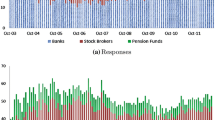Abstract
Central banks, statistical agencies, and international organizations such as the IMF and OECD typically use information about the exchange rate some weeks before the publication date as the basis for their exchange rate forecasts. This paper tests if exchange rate forecasts can be made more accurate by utilizing information about exchange rate movements closer to the publication date. To this end, we apply recent tests of equal predictability and encompassing for path forecasts. We find that the date on which the exchange rate forecast is based is crucial. Using exchange rate forecasts made by Statistics Norway over the period 2001–2018, we find that the random walk, when based on the exchange rate 1 day ahead of the publication deadline, encompasses the predicted path by Statistics Norway. However, when using the exchange rate 15 days before the publication deadline, the random walk path and the predicted exchange rate path by Statistics Norway have equal predictability.
Access this chapter
Tax calculation will be finalised at checkout
Purchases are for personal use only
Similar content being viewed by others
Notes
- 1.
We can also include a small sample correction for the heteroskedasticity. In this application, we apply the HC3 correction [16], which we operationalize by defining \(\tilde {d}_t = \frac {1}{1-h_t}\left ( {\mathbf {e}}^{A \prime }_{t,H|t} - {\mathbf {e}}^{B \prime }_{t,H|t} \right ) \hat {\Omega }_{(\hat {\alpha })}^{-1} \hat {\varepsilon }_t\), where \(h_t = D_t^{\prime }\left ( \sum _{j=1}^{T} D_{j} D_{j}^{\prime } \right )^{-1}D_t\) with \(D_t = {\mathbf {e}}^{A}_{t,H|t} - {\mathbf {e}}^{B}_{t,H|t}\).
- 2.
There are two exceptions: First, in the publication of the forecast made the first quarter in 2001, Statistics Norway only published a forecast for I-44 for the years 2001 and 2002. In our analysis, we assume that the forecasted value of I-44 for 2003 in the forecast published in the first quarter of 2001 is equal to the forecasted value for 2002, i.e., no change in the I-44 from 2002 to 2003 on a year-to-year basis. Second, Statistics Norway did not publish forecasts in the third quarter of 2013. In this analysis, we have set this forecast equal to the forecast made in the second quarter of that year. For the forecast based on the random walk, we have also used the exchange rate equal to the exchange rate in the market relative to the time the second quarter forecast from Statistics Norway was made.
References
Bank of Canada: Monetary Policy Report, January 2020. http://www.bankofcanada.ca/wp-content/uploads/2010/02/update120707.pdf
Bjørnland, H.C., Hungnes, H.: The importance of interest rates for forecasting the exchange rate. J. Forecast. 25(3), 209–221 (2006). https://doi.org/10.1002/for.983
Clements, M., Hendry, D.F.: Forecasting Economic Time Series. Cambridge University Press (Oct 1998). https://doi.org/10.1017/CBO9780511599286
Clements, M.P., Hendry, D.F.: On the limitations of comparing mean square forecast errors. J. Forecast. 12(8), 617–637 (1993). doi: https://doi.org/10.1002/for.3980120802
Doornik, J.A.: An Object-oriented Matrix Programming Language Ox7. Timberlake Consultants Press, London (2013). http://www.timberlake.co.uk/shop/ox-7-an-object-orientated-matrix-programming-language.html
Engel, C., Lee, D., Liu, C., Liu, C., Wu, S.P.Y.: The uncovered interest parity puzzle, exchange rate forecasting, and Taylor rules. J. Int. Money Finance 95, 317–331 (2018). https://doi.org/10.1016/j.jimonfin.2018.03.008
Ericsson, N.R.: On the limitations of comparing mean square forecast errors: Clarifications and extensions. J. Forecast. 12(8), 644–651 (Dec 1993). https://doi.org/10.1002/for.3980120806
European Central Bank: ECB staff macroeconomic projections for the euro area, March 2020, pp. 1–5 (2020). http://www.ecb.int/pub/pdf/other/ecbstaffprojections201209en.pdf
Giacomini, R., White, H.: Tests of conditional predictive ability. Econometrica 74(6), 1545–1578 (2006). https://doi.org/10.1111/j.1468-0262.2006.00718.x
Harvey, D.I., Leybourne, S.J., Newbold, P.: Testing the equality of prediction mean squared errors. Int. J. Forecast. 13(2), 281–291 (1997). https://doi.org/10.1016/S0169-2070(96)00719-4
Hungnes, H.: Encompassing tests for evaluating multi-step system forecasts invariant to linear transformations. Discussion Papers 871. Statistics Norway (2018). http://hdl.handle.net/11250/2560772
Hungnes, H.: Equal predictability test for multi-step-ahead system forecasts invariant to linear transformations. Discussion Papers 931. Statistics Norway (2020). http://hdl.handle.net/11250/2656482
Hungnes, H.: Predicting the exchange rate path - The importance of using up-to-date observations in the forecasts.pdf:pdf. Discussion Papers 934. Statistics Norway (2020). http://hdl.handle.net/11250/2663959
Hungnes, H.: Forecasting the Norwegian import-weighted krone exchange rate. Mendeley Data (2021). https://doi.org/10.17632/7schvgp54p.3
IMF: World Economic Outlook - January 2020. World Economic Outlook Update (January 2020). http://www.imf.org/en/Publications/WEO/Issues/2020/01/20/weo-update-january2020
MacKinnon, J.G., White, H.: Some heteroskedasticity-consistent covariance matrix estimators with improved finite sample properties. J Econ. 29(3), 305–325 (1985). https://doi.org/10.1016/0304-4076(85)90158-7
Meese, R.A., Rogoff, K.: Empirical exchange rate models of the seventies. J. Int. Econ. 14(1-2), 3–24 (1993). https://doi.org/10.1016/0022-1996(83)90017-X
Newey, W.K., West, K.D.: A simple, positive semi-definite, heteroskedasticity and autocorrelation consistent covariance matrix. Econometrica 55(3), 703–708 (1987). https://doi.org/10.2307/1913610
Oberhofer, W., Kmenta, J.: A general procedure for obtaining maximum likelihood estimates in generalized regression models. Econometrica 42(3), 579–590 (1987). https://doi.org/10.2307/1911792
Pesaran, M.H., Skouras, S.: Decision-based methods for forecast evaluation. In: Clements, M.P., Hendry, D.F. (eds.) A Companion to Economic Forecasting, chap. 11, pp. 241–267. Blackwell Publishing (2002). http://www.wiley.com/en-us/A+Companion+to+Economic+Forecasting-p-9781405171915
Rossi, B.: Exchange rate predictability. J. Econ. Lit. 51(4), 1063–1119 (2013). https://doi.org/10.1257/jel.51.4.1063
Statistics Norway: Economic Survey, 1/2019 (2019). http://www.ssb.no/en/nasjonalregnskap-og-konjunkturer/artikler-og-publikasjoner/economic-survey-1-2019
Williams, E.J., Kloot, N.H.: Interpolation in a series of correlated observations. Aust. J. Appl. Sci. 4(1), 1–17 (1953), http://hdl.handle.net/102.100.100/336863?index=1
Acknowledgements
Thanks to Pål Boug, Thomas von Brasch, Terje Skjerpen, participants at the 22nd Dynamic Econometric Conference in 2019 and the 42nd Annual Meeting of the Norwegian Association of Economists in 2020, the referees for and participants at the 7th International Conference on Time Series and Forecasting in 2021 for valuable comments, and the referees for this book chapter. Also, thanks to Trym Kristian Økland for collecting and organizing the data. An earlier version of this paper is available as a working paper from Statistics Norway [13].
Author information
Authors and Affiliations
Corresponding author
Editor information
Editors and Affiliations
Rights and permissions
Copyright information
© 2023 Statistics Norway
About this paper
Cite this paper
Hungnes, H. (2023). Predicting the Exchange Rate Path: The Importance of Using Up-to-Date Observations in the Forecasts. In: Valenzuela, O., Rojas, F., Herrera, L.J., Pomares, H., Rojas, I. (eds) Theory and Applications of Time Series Analysis and Forecasting. ITISE 2021. Contributions to Statistics. Springer, Cham. https://doi.org/10.1007/978-3-031-14197-3_13
Download citation
DOI: https://doi.org/10.1007/978-3-031-14197-3_13
Published:
Publisher Name: Springer, Cham
Print ISBN: 978-3-031-14196-6
Online ISBN: 978-3-031-14197-3
eBook Packages: Mathematics and StatisticsMathematics and Statistics (R0)




